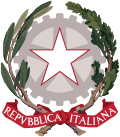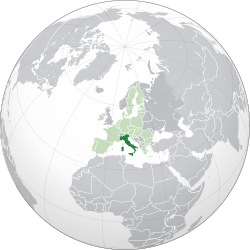
Back Италиа Abkhazian Itali ACE Италие ADY Italië Afrikaans Italien ALS Италия ALT ጣልያን Amharic Italy AMI Italia AN Italia ANG
Italian Republic Repubblica Italiana | |
|---|---|
| Anthem: "Il Canto degli Italiani" "The Song of the Italians" | |
Location of Italy (dark green) – in Europe (light green & dark grey) | |
| Capital and largest city | Rome 41°54′N 12°29′E / 41.900°N 12.483°E |
| Official languages | Italiana |
| Nationality (2021)[1] |
|
| Native languages | See main article |
| Religion (2020)[2] |
|
| Demonym(s) | Italian |
| Government | Unitary parliamentary republic |
| Sergio Mattarella | |
| Giorgia Meloni | |
| Ignazio La Russa | |
| Lorenzo Fontana | |
| Legislature | Parliament |
| Senate of the Republic | |
| Chamber of Deputies | |
| Formation | |
| 17 March 1861 | |
• Republic | 12 June 1946 |
| 1 January 1948 | |
| Area | |
• Total | 301,340[3][4] km2 (116,350 sq mi) (71st) |
• Water (%) | 1.24 (2015)[5] |
| Population | |
• 2024 estimate | |
• Density | 195.7/km2 (506.9/sq mi) (71st) |
| GDP (PPP) | 2024 estimate |
• Total | |
• Per capita | |
| GDP (nominal) | 2024 estimate |
• Total | |
• Per capita | |
| Gini (2020) | medium inequality |
| HDI (2022) | very high (30th) |
| Currency | Euro (€)b (EUR) |
| Time zone | UTC+1 (CET) |
• Summer (DST) | UTC+2 (CEST) |
| Calling code | +39c |
| ISO 3166 code | IT |
| Internet TLD | .it |
| |
Italy,[a] officially the Italian Republic,[b] is a country in Southern and Western Europe.[c] It consists of a peninsula that extends into the Mediterranean Sea, with the Alps on its northern land border, as well as nearly 800 islands, notably Sicily and Sardinia. Italy shares land borders with France to the west; Switzerland and Austria to the north; Slovenia to the east; and the two enclaves of Vatican City and San Marino. It is the tenth-largest country in Europe by area, covering 301,340 km2 (116,350 sq mi), and the third-most populous member state of the European Union, with nearly 60 million inhabitants. Italy's capital and largest city is Rome; other major urban areas include Milan, Naples, Turin, Palermo, Bologna, Florence, Genoa, and Venice.
The history of Italy goes back to numerous Italic peoples—notably including the ancient Romans, who conquered the Mediterranean world during the Roman Republic and ruled it for centuries during the Roman Empire. With the spread of Christianity, Rome became the seat of the Catholic Church and the Papacy. Barbarian invasions and other factors led to the decline and fall of the Western Roman Empire between late antiquity and the Early Middle Ages. By the 11th century, Italian city-states and maritime republics expanded, bringing renewed prosperity through commerce and laying the groundwork for modern capitalism. The Italian Renaissance flourished during the 15th and 16th centuries and spread to the rest of Europe. Italian explorers discovered new routes to the Far East and the New World, contributing significantly to the Age of Discovery.
After centuries of political and territorial divisions, Italy was almost entirely unified in 1861, following wars of independence and the Expedition of the Thousand, establishing the Kingdom of Italy. From the late 19th to the early 20th century, Italy rapidly industrialised—mainly in the north—and acquired a colonial empire, while the south remained largely impoverished, fueling a large immigrant diaspora to the Americas. From 1915 to 1918, Italy took part in World War I with the Entente against the Central Powers. In 1922, the Italian fascist dictatorship was established. During World War II, Italy was first part of the Axis until its surrender to the Allied powers (1940–1943), then a co-belligerent of the Allies during the Italian resistance and the liberation of Italy (1943–1945). Following the war, the monarchy was replaced by a republic and the country enjoyed a strong recovery.
A developed country with an advanced economy, Italy has the ninth-largest nominal GDP in the world, the second-largest manufacturing industry in Europe, and plays a significant role in regional and—to a lesser extent—global economic, military, cultural, and political affairs. Italy is a founding and leading member of the European Union, and is part of numerous other international organizations and forums. As a cultural superpower, Italy has long been a renowned global centre of art, music, literature, cuisine, fashion, science and technology, and the source of multiple inventions and discoveries. It has the highest number of World Heritage Sites (60) and is the fourth-most visited country in the world.
- ^ "Indicatori demografici, anno 2020" (PDF). Archived (PDF) from the original on 3 May 2021. Retrieved 3 May 2021.
- ^ "Special Eurobarometer 516". European Union: European Commission. September 2021. Archived from the original on 29 June 2023. Retrieved 24 September 2021 – via European Data Portal (see Volume C: Country/socio-demographics: IT: Question D90.2.).
- ^ "Italy". Central Intelligence Agency. 23 August 2023. Archived from the original on 1 July 2021. Retrieved 28 August 2023.
- ^ "Italy country profile". BBC News. 12 November 2023. Archived from the original on 18 December 2023. Retrieved 12 November 2023.
- ^ "Surface water and surface water change". Organisation for Economic Co-operation and Development (OECD). Archived from the original on 24 March 2021. Retrieved 11 October 2020.
- ^ "ISTAT – Demography, Statistics, Demographic Balance, Resident Population". demo.istat.it. Archived from the original on 6 July 2024. Retrieved 10 July 2024.
- ^ a b c d "World Economic Outlook Database, October 2024 Edition. (Italy)". www.imf.org. International Monetary Fund. 22 October 2024. Retrieved 22 October 2024.
- ^ "Gini coefficient of equivalised disposable income – EU-SILC survey". European Commission. Archived from the original on 9 October 2020. Retrieved 21 June 2022.
- ^ "Human Development Report 2023/24" (PDF). United Nations Development Programme. 13 March 2024. p. 288. Archived (PDF) from the original on 13 March 2024. Retrieved 13 March 2024.
- ^ "Legge Regionale 15 ottobre 1997, n. 26". Regione autonoma della Sardegna – Regione Autònoma de Sardigna. Archived from the original on 26 February 2021. Retrieved 31 May 2018.; "Regione Autonoma Friuli-Venezia Giulia – Comunità linguistiche regionali". regione.fvg.it. Archived from the original on 4 September 2015. Retrieved 2 November 2020.
- ^ "Comune di Campione d'Italia". Comune.campione-d-italia.co.it. 14 July 2010. Archived from the original on 30 April 2011. Retrieved 30 October 2010.
- ^ Academic works describing Italy as a Western European country:
- Hancock, M. Donald; Conradt, David P.; Peters, B. Guy; Safran, William; Zariski, Raphael (11 November 1998). Politics in Western Europe: an introduction to the politics of the United Kingdom, France, Germany, Italy, Sweden, and the European Union (2nd ed.). Chatham House Publishers. ISBN 978-1-5664-3039-5.
list of Western European countries Italy.
- Ugo, Ascoli; Emmanuele, Pavolini (2016). The Italian welfare state in a European perspective: A comparative analysis. Policy Press. ISBN 978-1-4473-3444-6.
- Zloch-Christy, Iliana (1991). East-West Financial Relations: Current Problems and Future Prospects. Cambridge University Press. ISBN 978-0-5213-9530-4. Retrieved 29 September 2019.
list of Western European countries Italy.
- Clout, Hugh D. (1989). Western Europe: Geographical Perspectives. Longman Scientific & Technical. ISBN 978-0-5820-1772-6. Retrieved 29 September 2019.
- Furlong, Paul (2003). Modern Italy: Representation and Reform. Routledge. ISBN 978-1-1349-7983-7. Retrieved 29 September 2019.
- Hanf, Kenneth; Jansen, Alf-Inge (2014). Governance and Environment in Western Europe: Politics, Policy and Administration. Routledge. ISBN 978-1-3178-7917-6. Retrieved 29 September 2019.
- Hancock, M. Donald; Conradt, David P.; Peters, B. Guy; Safran, William; Zariski, Raphael (11 November 1998). Politics in Western Europe: an introduction to the politics of the United Kingdom, France, Germany, Italy, Sweden, and the European Union (2nd ed.). Chatham House Publishers. ISBN 978-1-5664-3039-5.
Cite error: There are <ref group=lower-alpha> tags or {{efn}} templates on this page, but the references will not show without a {{reflist|group=lower-alpha}} template or {{notelist}} template (see the help page).
© MMXXIII Rich X Search. We shall prevail. All rights reserved. Rich X Search



